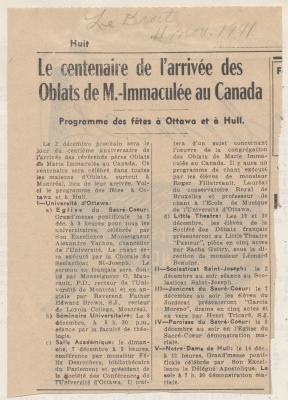At the request of the Bishop of Montréal, Msgr. Ignace Bourget, the Oblates settle in Bytown in 1844 to structure the religious life of the growing Catholic population. They do not yet know it, but they will be inextricably linked to the fate of Ottawa’s Francophone community, and to debates that will stir up strong emotions.
Founded in Marseilles (France) in 1816 by Eugène de Mazenod, the congregation of the Oblates of Mary Immaculate (OMI) is dedicated to evangelizing the poor. The Oblates have been in Canada for only three years when they land in Bytown. Nothing, then, predisposes them to playing a particularly significant cultural and national animating role in French Canada.
The first Oblates to settle in the future capital of Canada all come from France. They see their role as essentially religious rather than linguistic or cultural. The Catholic population of the region is mixed, composed of both French and Irish Canadians, two groups engaged in fierce, sometimes violent, competition for control of logging operations in the Ottawa Valley. The Oblates, preferring to maintain neutral, set up structures adapted to the linguistic and cultural duality of the region’s Catholic community.
The Diocese of Bytown, established in 1847, is therefore bilingual. It brings together French-Canadians and Irish Catholics without discrimination. Bishop Joseph-Bruno Guigues, superior of the congregation in Canada appointed to head the new diocese, defends it bitterly. He imposes bilingualism on the cathedral. He also advocates for a ministry of priests to work within the two linguistic communities. He says that “the difficulty of serving an Irish congregation is exaggerated. A French priest who has some English can serve it, and often does so more successfully than an Irish priest...”1
In 1848, Bishop Guigues founds the College of Bytown, which will become the University of Ottawa. It is also a bilingual institution. The Oblates to whom he entrusts the leadership will try to unite the two linguistic groups by providing bilingual education and bringing them together in the same classes. But here, as in other institutions they create in the Ottawa area, the Oblates confront the growing will of Ontario Anglophones to assert its English and Protestant nature. And the Oblates will, despite themselves, become involved in major national issues that challenge English-speaking and French-speaking Canadians, particularly in education.
1 Reported by Robert Choquette, L’Église catholique dans l’Ontario français du dix-neuvième siècle, Ottawa, University of Ottawa Press, 1984, p. 151 (translated from the original).
Seminarians of the Oblates of Mary Immaculate on a river near [Ottawa], [1910-1914].
Source: University of Ottawa, CRCCF, Fonds Georges-Michaud (P62), Ph59-707.



